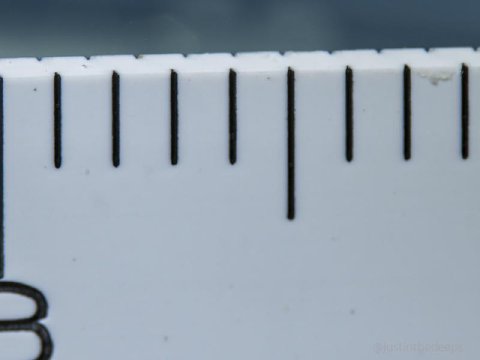
(CC-BY-NC-ND)
iNaturalist.org
Isopontonia platychelesSmaller subjects → smaller lenses?
Some of the most captivating underwater photography that we see is ‘macro,’ or small (less than ~5-10cm) subjects photographed in dramatically lit and framed positions.
This is dominated by large ‘full-frame’ cameras with huge sensors, massive lenses, and beefy add-on magnifiers (close-up lenses, aka ‘diopters’), whose sensitivity and performance capture stunning imagery through small apertures, razor-thin depths of field, and specialized lighting.
The optical physics of imaging something far smaller than a full-frame lens–and even smaller than the sensor itself–is challenging. Filling the frame with a ~5mm (or smaller) object is not easy! Raw images are often cropped down, to ’enlarge’ the subject in the frame. With an abundance of high quality megapixels, this is easily done at a factor of 2x+ in post-production, featuring near-micro details.
But what if we could just use smaller lenses and sensors to get a tighter field of view to begin with? Enter micro four-thirds gear.
‘Pre-cropped’ images
Micro four-thirds (MFT) lenses are often described in terms of their ‘full-frame equivalent focal length.’ This is inaccurate.
An MFT lens does not magically create twice the focal length of a full frame lens. What it does do is collect a narrower field of view for equivalent length, which means you can fill your frame with tiny subjects, without having to crop the image that would have resulted from a larger lens of the same focal length.
This is very useful for travelers, and for people seeking smaller subjects. A good quality 90mm macro lens on a full-frame camera is impressively large, and relatively heavy. A 90mm MFT lens is much lighter, and will achieve results comparable to cropping down all of your full frame photos by 2x (commonly done). Additionally, the working distance, maximum magnification, and depth of field can also be improved on an MFT lens.
The OM System 90mm macro lens for example can capture ‘2:1 reproduction ratios’ at a reasonable working distance of 5-6cm, without needing any close-up lens (or ‘diopter,’ for the hipsters). This makes it dramatically more portable than a full-frame 90mm lens + a large/heavy (e.g. +10) close-up lens in front of it.
Minimum FOV @ minimum focus distance
Typical specs given for lenses are often in ‘reproduction ratios’ and such, which isn’t very helpful or concrete.
As a ‘macro shooter,’ what I want to know is:
- What fits in my frame?
- How much of my frame will be taken up by a 5mm or 10mm subject?
To explore this in MFT macro lenses, I took a few test photographs of a metric measuring tape (in air, on land) at the minimum focus distance.
The legendary Olympus / OM System ‘Tough’ series (aka TG-4/5/6/7) is included for comparison. This little alien ‘dropped a mic’ on super-macro/micro photography, with its snappy operation, robustness, vivid color rendering, onboard optical zoom, and microscope/super-macro focus mode.
Comparison Table
Here is a table of minimum working distances (from subject to front of the lens) and the effective field of view at this distance, for some MFT macro lenses. Note that ‘minimum focus distance’ given in lens specs are measured from subject to lens focal point, far inside the lens near the sensor. The values are rough estimates from pictures of a millimetre measuring tape.
| Lens | Minimum working distance | Field of view (width) at MWD |
|---|---|---|
| (TG-6) | [Touching the subject] | ~4.5 mm |
| OM 60mm | 7-8cm | ~16.5 mm |
| OM 60mm & INON +6 | ~5cm | ~11 mm |
| OM 60mm & AOI +12.5 | ~2cm | ~10 mm |
| OM 90mm | 5-6cm | ~8 mm |
| OM 90mm & INON +6 | 2-3cm | ~5.5 mm |
| OM 90mm & AOI +12.5 | 1-2cm | ~5 mm |
| Laowa 50mm MFT | ~4cm | ~9 mm |
| Laowa 50mm MFT & INON +6 | 2-3cm | ~7 mm |
| OM 30mm | 2-3cm | ~13 mm |
| OM 300mm f4 | 120cm | ~71 mm |
These working distances (at the minimum focus distance) were roughly measured with a ruler in air, on land, using a basic head torch for lighting, without a camera housing. As things like refraction through flat ports affect apparent distances underwater, I will need to repeat these measurements underwater at some convenient time in the near future.
The field of view column lists roughly how much of a metric measuring tape fits into the frame at the minimum working distance. Here is the same data in chart form:
Olympus / OM System TG-6
The TG can achieve a crazy tight field of view (~4mm) when zoomed in and touching the subject–here a measuring tape. But it is nearly impossible to illuminate the scene, and quality suffers greatly:
justinthedeeps.com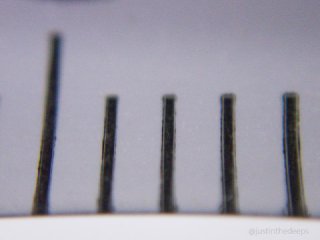
Here is what the TG-6 sees at a more ‘reasonable’ working distance of ~1-2cm, where it crisply resolves the details of about ~10mm of tape. For center-focused (or snooted) subjects, which is most macro, this rivals (or beats) much larger and premium camera/lens systems. This proximity is still challenging though, for reasons including lighting, access, and disturbing the subject or its environment:
justinthedeeps.com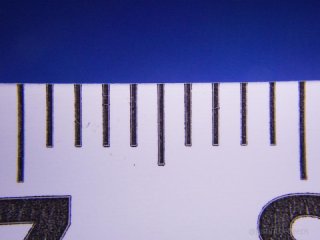
MFT Macro Lenses
By comparison, here are casual images at minimum focus distance for a few MFT lenses. These images were taken purely for measurement purposes, and do not necessarily represent directly comparable photographic results!
M.Zuiko Digital ED 60mm F2.8 Macro
The 60mm macro lens from OM System is a flagship product that continues to please and impress even longstanding full-frame pro photographers. For small subjects like nudibranchs and shrimp it can do the same job as many full-frame rigs, and perhaps even more–in a stunningly small & lite package.
Here is how its closest focus points measure up:
justinthedeeps.com justinthedeeps.com justinthedeeps.com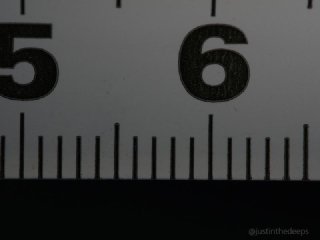
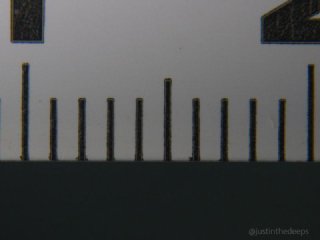
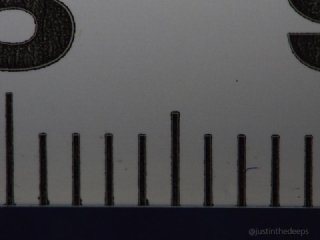
M.Zuiko Digital ED 90mm F3.5 Macro IS PRO
The 90mm macro lens from OM System is described by many as a specialist lens for very small subjects. Not only does its focal length promise 50% more power over the 60mm, but its minimum focus distance is actually quite close as well. This results in two-fold ‘closer’ images (8mm vs. ~16mm minimum FOV width: hence the ‘2:1’ vs. ‘1:1’ ratings.)
With the onboard range selector, this lens feels like having a built-in close-up lens already included inside the body. The highly touted autofocus performance is not infallible; I still decouple my focus and shutter buttons when using this lens, ‘breathing’ the camera forward and back with focus peaking on, and appreciate having a physical manual focus knob for greater focusing control.
justinthedeeps.com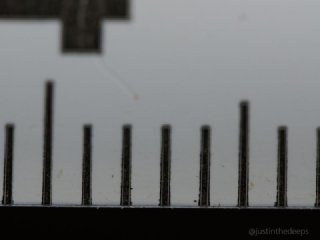
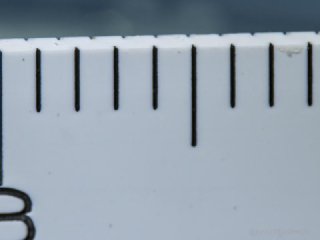
justinthedeeps.com
While an additional close-up lens is certainly not needed in front of this lens, it appears completely fine to add on a +6 or +12.5 (with some sacrifices to working distance):
justinthedeeps.com justinthedeeps.com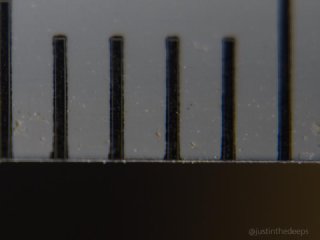
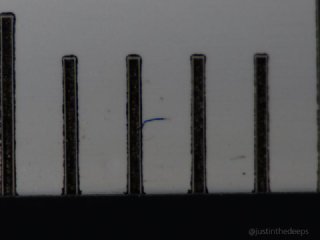
Laowa 50mm f/2.8 2X Ultra Macro APO
The 50mm MFT macro lens from Laowa covers an optical base that doesn’t exist in the OM range. It remains very compact like the OM 60mm, but can focus much closer. The result at its minimum focus distance is comparable to the OM 90mm lens, and it does so with a wider/faster aperture capability. I find my images with this lens benefit from increased clarity and depth of field, compared to super-macro captures on the 90mm. I think it also makes a very nice macro/super-macro video lens. The main drawback is: no autofocus! I have been able to adapt a Nauticam focusing ring to work with this lens.
The Laowa MFT 50mm macro lens is capable of great super-macro images with close focus, per below. Even the +6 close-up lens can work, apparently. But don’t bother with anything thicker! The close working distance of this lens already does the job.
justinthedeeps.com justinthedeeps.com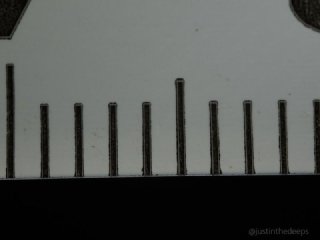
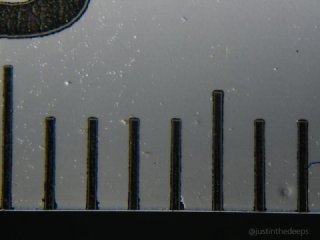
M.Zuiko Digital ED 30mm F3.5 Macro
The 30mm macro lens from OM System is likely overlooked, sitting in the shadow of its higher fidelity sibling, the 60mm. It does not impress with its modest (small) iris. However, this lens has an impressively close minimum focus distance.
This lens actually fills the frame with a smaller field of view than the 60mm! (~13mm, vs ~16.5mm for the 60mm: a ‘reproduction ratio’ of 1.25x.) It can focus about three times closer than the 60mm. That might be a bit too close for some things, but you can pull back to a ‘60mm full frame equivalent (field of view)’ as well, which is an underrated range for things like adult frogfish or blackwater dives.
Here we see that the 30mm beats the 60mm in terms of minimum field of view, which is exactly why I wanted to do this test/blogpost.
justinthedeeps.com justinthedeeps.com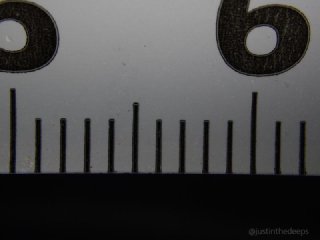

Summary
At these close ranges, the superior quality of proper MFT lenses over the TG-6 is clear. While well lit TG images will continue to impress, many of us are upgrading to MFT.
The luscious bokeh of [cropped?] 50+ megapixel full frame images will also continue to captivate, but this is no longer the only or best option for top level photography of small subjects. Size and weight-conscious travelers (and lens hoarders) in particular might be better served by today’s micro four-thirds options. It doesn’t hurt that the price points are often lower. The improved working distance and fidelity of the MFT lenses introduce an unparalleled quality, lightness and convenience for small subject photography.
Close-up lenses with MFT macro
I found it interesting what happens with the +6 and +12.5-dioptre close-up lenses, when paired with MFT macro lenses.
The INON +6 close-up lens is about 2cm thick. The physical space that this add-on lens occupies eats into our working distance, but in doing so, achieves a significantly tighter field of view (increased magnification): about one third ‘closer’ in the case of the 60mm (11 vs 16.5mm), and nearly that with the 90mm (5.5 vs 8mm). The result is a net benefit, for super-macro (or even micro) purposes.
The thicker (and heavier) +12.5 takes up a whopping 4cm of working distance, which begins to yield diminishing returns when placed in front of the MFT lenses. While sacrificing nearly all of our working distance, the +12.5 seems to get the 60mm or 90mm MFT lenses only about 10% tighter than the +6.
A benefit some keen eyes will notice is that the AOI UCL-09PRO +12.5 shows significantly less chromatic aberration at the periphery compared to the INON UCL-165, the importance of which will depend on background composition. For black backgrounds typical of many strongly-flashed or blackwater images, this will be less consequential.
(‘UCL’ stands for ‘underwater close-up lens,’ which is a more accurate way to refer to type of lens than than ‘diopter’)In the case of the 90mm macro lens, adding +6 or +12 close-up lens approaches the tightest FOV that the TG-6 can do, but with much more reliable quality, and a working distance that still allows for lighting.
These close-up lenses do provide some increased magnification in front of the OM System macro lenses, but it is nice to see that when using these specialized high-magnification, close-focusing lenses, big chonky add-on close-up lenses and flip adapters (etc.) are completely optional. Those of us who use MFT setups in part for weight and size savings can achieve top-level magnification and detail with a much smaller dive rig, especially without close-up lenses or flip adapters.
Real world examples
Here are a few recent underwater results with these MFT lenses, which I hope mean a bit more now in context of this discussion about what kind of gear we need for pleasing results.
(CC-BY-NC-ND) iNaturalist.org (CC-BY-NC-ND) iNaturalist.org (CC-BY-NC-ND) iNaturalist.org (CC-BY-NC-ND) iNaturalist.org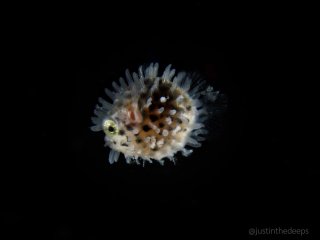

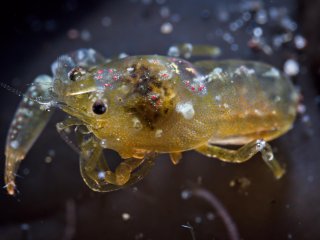
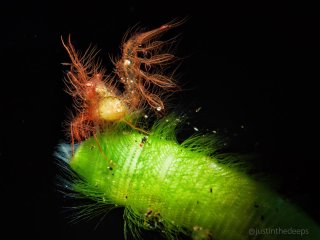
My original motivation for getting out a measuring tape was to calibrate my camera/lens setups for estimating the sizes of real subjects, by creating a curve of the computed focus distance (included in EXIF info) versus controlled measurements (pictures of a ruler) at several known distances. There are calculators for field of view that can be used for this, but I suspect they will be systematically inaccurate for camera lenses underwater in dive housings. In-water results will have to come in a future post.

